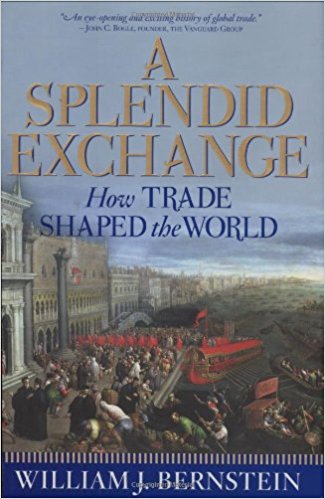A Splendid Exchange Summary
5 min read ⌚
 How Trade Shaped the World
How Trade Shaped the World
Nowadays people are used to buying goods from other states, no matter how far they are. Foreign trading has always been a part of human’s lives and played an essential role in society’s development.
Who Should Read “A Splendid Exchange”? And Why?
For instance, he demystifies the Boston Tea Party, the event that helped the American Revolution, which in reality was not a demonstration of patriotism. Conversely, it was a sneaky trick by smugglers and dealers that cost the colonists a considerable amount of money.
Then, he talks about how an Ethiopian herder may have stumbled upon coffee when he saw his goats and camels running around joyfully throughout the night after eating the red berries of an unfamiliar bush, etc.
Although Bernstein has filled “A Splendid Exchange” with such details, his principal goal is evident: presenting a comprehensive report on global trade from its ancient beginnings to the present day.
We are sure that any reader will enjoy this piece of adventurous writing, as well the historical insight on a topic that is an inseparable part of all of our lives.
About William Bernstein
 William Bernstein, Ph.D., M.D., is a retired neurologist situated in Oregon. Famous for his site on asset allocation and portfolio theory Efficient Frontier, Dr. Bernstein is a co-chief in the money administration company Efficient Frontier Advisors. He is the author of a few best-selling books on finance and history and is frequently cited in the national financial media.
William Bernstein, Ph.D., M.D., is a retired neurologist situated in Oregon. Famous for his site on asset allocation and portfolio theory Efficient Frontier, Dr. Bernstein is a co-chief in the money administration company Efficient Frontier Advisors. He is the author of a few best-selling books on finance and history and is frequently cited in the national financial media.
“A Splendid Exchange Summary”
Archeologists have found some clues that show that even in ancient times people were exchanging goods over long distances. The earliest trade by water is thought to be an exchange between farmers and hunter-gatherers.
However, people transported only the most precious items and trading everyday goods were not as frequent as it is today: first because the costs for transport were too high, and second because transporting was a dangerous activity.
Bandits wandered around, looking for merchants who they could kill and take their products. Water trade was overwhelming: navigation was primitive, ships were rickety, pirates were all over the place, and the unsafe weather sank many ships. Nonetheless, products kept on moving, driven by the vast profits to be made by trading.
During the late Pleistocene time, that lasted until 10,000 years ago, a bridge (Beringia), existed between the eastern and western sides of the equator. As a result, animals and plants were able to pass from the Old to the New World and vice versa.
People moved west to the New World, and camels and stallions – east into the Old World. Camels can store water, so they can last a long time without needing hydration. Apart from that, they sweat less and consequently lose less of the stored liquid than other species, making them a perfect fit for life in parched areas.
Camels rapidly became essential for transporting products all around Asia. Traders sometimes used donkeys as well, but the camels did the most significant portion of the work.
At first, dealers carried just the products that were the most significant and held a reasonable market value, like perfumes, incense, and body oils. The demand for such goods was quite high in the period when people wore the same garments over and over again and rarely showered.
Along these products, silk, myrrh, and frankincense were the most cherished merchandise. Amid the 14th to the 17th centuries, nutmeg, cinnamon, cloves, pepper and different goods supplanted incense and scents as the most valuable trade products.
By the 16th century, the Portuguese ruled the ocean trade with Asia, closely trailed by the Genoese and Venetians, and after that the Dutch.
Distant trading had many positive aspects, especially for those who engaged in it: from wealthy individuals who wore ravishing silk to nations who utterly depended on imported grains for sustenance.
Be that as it may, apart from goods, trade in ancient times transported lethal illnesses as well, for example, the grisly Black Death, a plague unintentionally brought from Asia to Europe and the East, where it murdered somewhere around a hundred million men and women.
Key Lessons from “A Splendid Exchange”
1. Discovery of the New World
2. A small world
3. Free trade
Discovery of the New World
In the late 1400s, Genoese sailor Christopher Columbus requested that the Spanish government subsidized his voyage west to reach the famous markets in China and India.
At this point, most educated individuals accepted, as did Columbus, the fact that the Earth was round. In any case, King Ferdinand and Queen Isabella considered his expedition so difficult and unreliable that they disagreed with it at first. Be that as it may, at the end they authorized his undertaking.
In 1492, Columbus and his three boats got to the New World. At the same time, Portuguese pilgrim Vasco da Gama cruised at total 28,000 miles around the globe. His ships were on the sea for 95 days.
At the time, these were incredible accomplishments, and after them, worldwide exchange and business could never be the same.
A Small World
As the world became more accessible and, hence, “smaller,” worldwide trade changed profoundly. After the 1700s, ranchers in numerous areas were able to deliver New World products of high value, for example, cotton, coffee, sugar, and tea.
By the 1700s, cotton turned out to be more alluring than silk. These progressions changed global trade. The 1800s brought significant transportation innovations and improvements, including railways, steamships and refrigeration strategies.
Manufacturers had a more extensive choice of means of transport, and thus, could ship their goods further and faster, and all that for a smaller price. These advances significantly stimulated world trade.
Free Trade
The U.S. used to favor protectionism by setting high import charges. When it comes to parties, Republicans support protectionism, while Democrats are less fascinated by it.
The 1930 Smoot-Hawley Tariff, increased the already extreme taxes on imports, inciting different countries to respond in the same way. Thus, global trade nearly stopped in the mid-1930s.
Cordell Hull, secretary of state under President Roosevelt, utilized his influence to encourage free trade. Nowadays, free trade benefits a lot of people around the world.
Like this summary? We’d Like to invite you to download our free 12 min app, for more amazing summaries and audiobooks.
“A Splendid Exchange” Quotes
In Battuta's obsession with sharia and the Muslim world and in his lack of interest in nearly everything outside it we clearly see the double-edged sword of Islam so visible in today's world: an ecumenical but self-satisfied faith capable… Share on X Globalization, it turns out, was not one event or even a sequence of events; it is a process that has been slowly evolving for a very, very long time. Share on X Although free trade benefits mankind in the aggregate, it also produces losers who cannot be expected to passively accept the new order. Share on X For most of recorded history, the primary manufactured trade commodity was cloth. Share on X On some unrecorded occasion deep in prehistory, a man, or several men, initiated early long-distance trade by setting out on the water in boats. Share on XOur Critical Review
This book offers an understandable and valuable insight into the timeline of world trade, wrapped inside splendid bits of writing. Furthermore, along the way Bernstein tosses in enchanting little-known facts and details, which make the book even more fascinating.
Emir is the Head of Marketing at 12min. In his spare time, he loves to meditate and play soccer.


 How Trade Shaped the World
How Trade Shaped the World




